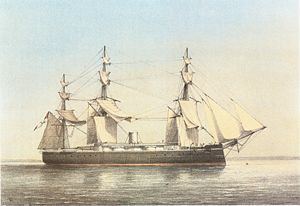Name HMS Monarch Fate Broken up, 1905 Construction started 1 June 1866 Length 101 m Completed 12 June 1869 | Laid down 1 June 1866 Beam 57 ft 6 in (17.53 m) Launched 25 May 1868 | |
 | ||
Displacement 8,322 long tons (8,456 t) Draught 22 ft 6 in (6.86 m) light26 ft (8 m) deep load | ||
HMS Monarch was the first seagoing British warship to carry her guns in turrets, and the first British warship to carry guns of 12-inch (300 mm) calibre.
Contents
Design
She was designed by Sir Edward Reed, at a time when the basic configuration of battleship design was undergoing major change simultaneously in many aspects. Sail was gradually giving way to steam, wooden hulls had just been superseded by iron, smoothbore artillery firing round-shot had been overtaken by rifled shell-firing cannon, increasingly heavier armour was being mounted, and there was mounting agitation in naval design circles to abandon broadside armament in favour of that mounted in turrets. In this melting-pot, any battleship design was fated to be a compromise, and the design of Monarch proved to be so.
Having determined that Monarch would carry her main artillery in turrets, the Board of Admiralty then stipulated that, as she was destined for overseas service, and steam engines were not at that time wholly reliable, she must carry a full ship-rig and be fitted with a forecastle. Reed objected to this concept, which had the effect of totally preventing the main artillery from firing on any other angle than on the port and starboard beams. He was overruled, and is reported to have taken little pride in the resulting ship. He himself wrote, in 1869 "no satisfactorily designed turret ship has yet been built, or even laid down.....the middle of the upper deck of a full-rigged ship is not a very eligible place for fighting large guns". In 1871 Reed stated to the Committee on Designs that he wanted on a turret ship no poop and no forecastle, and masts carrying at most light rig past which the guns could fire fore or aft on the centre-line.
The hull of Monarch was different in no significant particular from the hulls of recent broadside ironclads, except that her lines were finer, with a length: beam ratio of 5.7:1; a ratio which was not bettered for a battleship until the building of HMS Dreadnought with a ratio of very nearly 6:1.
Modernisation
In 1890 she was selected for what was at the time called "modernisation". She was given new triple expansion engines and new boilers, and thereafter could make 15.75 knots (29.17 km/h) – less than a knot better than on her first trials. No attempt was made to bring her armament up to date, although the muzzle-loading rifles which she carried were by then totally obsolete, and the fitting of breech-loading cannon would not have been difficult. At this time she received four 12-pounder and ten 3-pounder quick-firers as a torpedo-boat defence.
Armament
The four 12-inch muzzle-loading rifles carried as main armament were housed in two pairs in two centre-line turrets on the upper deck, one on either side of the funnel. These guns, each of which weighed 25 long tons (25 t), could fire a shell weighing 600 pounds (270 kg) with a muzzle velocity of 1,380 ft/s (421 m/s). Being situated on the upper deck, at a height of seventeen feet above water, they were seven feet higher than any battery in the fleet, with significant advantage thereby accruing in terms of range and command. Unlike earlier turret-equipped coast-defence ships, training was by steam power.
A good gun crew could fire an aimed shell every two minutes.
To compensate for the inability of the main guns to train either fore or after, two smaller guns of 7 inch calibre were carried in the bow, and one in the stern.
Service history
She was commissioned for the Channel Fleet at Chatham, and served therein until 1872. During the service she crossed the Atlantic in the company of USS Plymouth carrying the remains of George Peabody, American merchant, financier and philanthropist, to the United States for burial. On her way home she sailed on one day a distance of 242 nautical miles (448 km), which fell short of the record set by HMS Ocean by one nautical mile only. She paid off for refit, rejoining the Channel Fleet in 1874. In 1876 she was posted to the Mediterranean, where she served until 1885, with a short refit at home in 1877. She was present and active at the bombardment of Alexandria in 1882 firing 125 12-inch (300 mm) shells at the Egyptian forts. She was ordered to Malta in the Russian war scare of 1885, but broke down en route and her whereabouts were unknown for some days; she was ultimately found, towed into Malta, patched up and sent home under escort. After refit she again served in the Channel between 1885 and 1890. She spent the years from 1890 to 1897 undergoing a lengthy modernisation, after which she was guardship at Simon's Bay until 1902. Captain Charles Henry Bayly was appointed in command on 1 February 1900. In March 1902 Captain Robert Kyle McAlpine was appointed in command, for service as Naval Officer in Charge Ascension. Two months later, Captain William Lowther Grant was appointed in command on 5 May 1902, and in July 1902 she was part of a group of seven Royal Navy ships visiting Zanzibar for a show of force following the death of the sultan and accession of his son. She was thereafter reduced to the status of a depot ship under the new name of HMS Simoon; brought home in 1904, she was sold in 1905.
